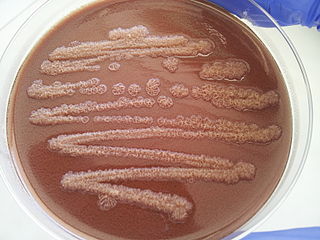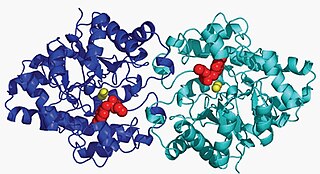Acidovorax facilis is an aerobic, chemoorganotrophic bacterium used as a soil inoculant in agriculture and horticulture.
Pseudomonas agarici is a Gram-negative soil bacterium that causes drippy gill in mushrooms. It was first isolated in New Zealand. P. agarici could not be grouped based on 16S rRNA analysis, so it is designated incertae sedis in the genus Pseudomonas.
Pseudomonas thivervalensis is a Gram-negative soil bacterium that infects the roots of Arabidopsis thaliana. Based on 16S rRNA analysis, P. thivervalensis falls within the P. fluorescens group. It derives its name from the fact that it was first isolated in Thiverval, France.
Pseudomonas citronellolis is a Gram-negative, bacillus bacterium that is used to study the mechanisms of pyruvate carboxylase. It was first isolated from forest soil, under pine trees, in northern Virginia, United States.
Pseudomonas segitis is a Gram-negative, aerobic soil bacterium found in Korea. The type strain is IMSNU 14101.
Pseudomonas moraviensis is a Gram-negative soil bacterium. It is named after Moravia, the region of the Czech Republic where it was first isolated. The type strain is CCM 7280T.
Pseudomonas vranovensis is a Gram-negative soil bacterium.
Pseudomonas jinjuensis is a Gram-negative, non-spore-forming, motile, single polar flagellated, yellow-white, rod bacterium isolated from soil in the Jinju Region of Korea. The type strain is LMG 21317.
Pseudomonas koreensis is a Gram-negative, non-spore-forming, motile, multiple polar flagellated, yellow-white, rod bacterium isolated from farming soil in Korea. The type strain is LMG 21318.
Pseudomonas umsongensis is a Gram-negative, non-spore-forming, motile, single polar-flagellated, yellow-white, rod-shaped bacterium isolated from the soil in the Umsong region of Korea. The type strain is LMG 21317.
Pseudomonas kilonensis is a Gram-negative soil bacterium isolated from agricultural soil in Germany. The type strain is DSM 13647.
Pseudomonas balearica is a Gram-negative, rod-shaped, nonfluorescent, motile, and denitrifying bacterium. It is an environmental bacterium that has been mostly isolated from polluted environments all over the world. Many of the isolates have demonstrated capabilities to degrade several compounds. Some of the strains are naphthalene degraders and one strain isolated in New Zealand has demonstrated the potential to oxidize inorganic sulfur compounds to tetrathionate. Based on 16S rRNA analysis, P. balearica has been placed in the P. stutzeri group.
Pseudomonas lini is a fluorescent, Gram-negative, rod-shaped bacterium isolated from rhizospheric soil in France. The type strain is CFBP 5737, though there are also eight other strains known. This bacterium has also been isolated from endophytic tissues of lodgepole pine trees growing on gravel mining sites with potential to perform biological nitrogen fixation and plant growth promotion.

Pseudomonas stutzeri is a Gram-negative soil bacterium that is motile, has a single polar flagellum, and is classified as bacillus, or rod-shaped. While this bacterium was first isolated from human spinal fluid, it has since been found in many different environments due to its various characteristics and metabolic capabilities. P. stutzeri is an opportunistic pathogen in clinical settings, although infections are rare. Based on 16S rRNA analysis, this bacterium has been placed in the P. stutzeri group, to which it lends its name.
Pseudomonas rathonis is a Gram-negative bacterium originally isolated from the rhizosphere of agriculturally important crops.
Chromohalobacter beijerinckii is a motile, rod-like, salt-loving, Gram-negative soil bacterium, 0.4–0.6 μm by 1.8–2.5 μm.

Aryldialkylphosphatase is a metalloenzyme that hydrolyzes the triester linkage found in organophosphate insecticides.
Green nails may be (1) due to a Pseudomonas aeruginosa infection causing a green nail syndrome or (2) the result of copper in tap water.
Pseudomonas protegens are widespread Gram-negative, plant-protecting bacteria. Some of the strains of this novel bacterial species previously belonged to P. fluorescens. They were reclassified since they seem to cluster separately from other fluorescent Pseudomonas species. P. protegens is phylogenetically related to the Pseudomonas species complexes P. fluorescens, P. chlororaphis, and P. syringae. The bacterial species characteristically produces the antimicrobial compounds pyoluteorin and 2,4-diacetylphloroglucinol (DAPG) which are active against various plant pathogens.
Paraglaciecola mesophila is a Gram-negative, slightly halophilic, heterotrophic and motile bacterium from the genus of Paraglaciecola which has been isolated from the liquor of an ascidian from the Troista Bay in Russia.

